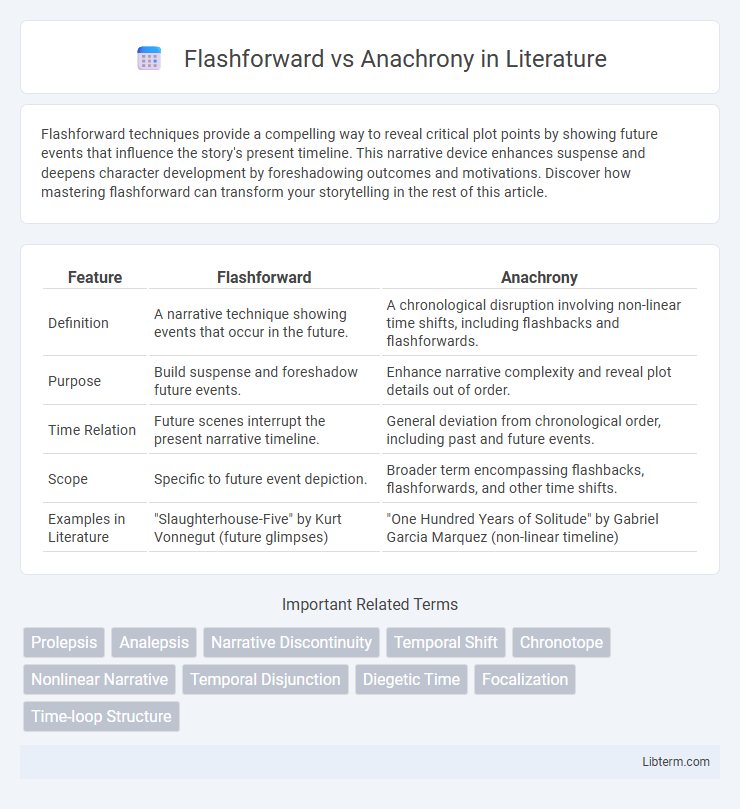Flashforward techniques provide a compelling way to reveal critical plot points by showing future events that influence the story's present timeline. This narrative device enhances suspense and deepens character development by foreshadowing outcomes and motivations. Discover how mastering flashforward can transform your storytelling in the rest of this article.
Table of Comparison
| Feature | Flashforward | Anachrony |
|---|---|---|
| Definition | A narrative technique showing events that occur in the future. | A chronological disruption involving non-linear time shifts, including flashbacks and flashforwards. |
| Purpose | Build suspense and foreshadow future events. | Enhance narrative complexity and reveal plot details out of order. |
| Time Relation | Future scenes interrupt the present narrative timeline. | General deviation from chronological order, including past and future events. |
| Scope | Specific to future event depiction. | Broader term encompassing flashbacks, flashforwards, and other time shifts. |
| Examples in Literature | "Slaughterhouse-Five" by Kurt Vonnegut (future glimpses) | "One Hundred Years of Solitude" by Gabriel Garcia Marquez (non-linear timeline) |
Understanding Flashforward: Definition and Purpose
Flashforward is a narrative technique that presents future events ahead of the chronological timeline to create suspense and engage the audience. It reveals pivotal moments or outcomes to deepen the story's complexity and foreshadow consequences. In contrast to Anachrony, which involves any deviation from linear time, Flashforward specifically projects forward, enhancing anticipation and thematic depth in storytelling.
What is Anachrony? Exploring Temporal Displacement
Anachrony is a narrative technique involving temporal displacement, where events are presented out of chronological order to create suspense or deepen thematic complexity. Unlike straightforward flashforwards, anachronies manipulate time by including flashbacks, flashforwards, or ellipses that disrupt linear storytelling. This method enables authors and filmmakers to reveal crucial plot points non-sequentially, enhancing audience engagement through layered temporal structures.
Key Differences Between Flashforward and Anachrony
Flashforward depicts a narrative jump forward in time, revealing future events to the audience, while anachrony involves any temporal disruption in the chronological sequence, including flashbacks and flashforwards. Flashforward specifically anticipates plot developments and builds suspense, whereas anachrony serves as a broader category encompassing all time shifts that affect the story's temporal structure. The key difference lies in flashforward's exclusive forward-looking use, contrasting with anachrony's inclusive approach to all non-linear time presentations.
Narrative Functions of Flashforward in Storytelling
Flashforward in storytelling propels the narrative by revealing future events, creating suspense and foreshadowing outcomes that shape audience expectations. Unlike Anachrony, which broadly encompasses any non-linear time shifts, Flashforward specifically directs attention forward in time to highlight consequences and character development. This technique enhances plot complexity, deepens thematic resonance, and intensifies emotional engagement by contrasting present actions with future ramifications.
Types of Anachrony: Prolepsis, Analepsis, and More
Flashforward is a narrative technique that projects the story into future events, often creating suspense or foreshadowing outcomes. Anachrony encompasses various time-related disruptions, including prolepsis (flashforward), analepsis (flashback), and other temporal shifts that reorder chronological sequences for thematic or structural purposes. These techniques manipulate narrative time to enhance storytelling depth and reader engagement by revealing crucial information outside the linear timeline.
Common Uses of Flashforward in Literature and Film
Flashforward is commonly used in literature and film to foreshadow future events, enhancing suspense and viewer or reader engagement. It allows creators to reveal critical plot points or character outcomes out of chronological order, driving anticipation. Works like "Lost" and "Breaking Bad" utilize flashforwards to deepen narrative complexity and provide insights into character development.
How Anachrony Shapes Plot and Reader Perception
Anachrony, by disrupting chronological order through flashbacks or foreshadowing, fundamentally alters plot structure and reader engagement by revealing critical information non-linearly. This technique deepens narrative complexity and compels readers to actively piece together events, enhancing suspense and thematic resonance. Flashforward, in contrast, specifically projects future events, creating anticipatory tension but maintaining a more straightforward temporal relationship compared to anachrony's broader manipulation of timeline.
Flashforward vs. Flashback: Clarifying the Confusion
Flashforward and flashback are narrative techniques that manipulate the chronological order of events to enhance storytelling but serve opposite purposes; flashforward reveals events that will happen in the future, whereas flashback provides context by revisiting past events. In film, television, and literature, flashforwards build suspense and foreshadow outcomes, while flashbacks deepen character development and background understanding. Understanding the distinction between flashforward and flashback is crucial for analyzing plot structure and interpreting timelines within complex narratives.
Advantages and Challenges of Using Anachrony
Anachrony allows storytellers to manipulate the narrative timeline, enabling deeper exploration of characters and events by presenting information out of chronological order, which enhances suspense and thematic complexity. This non-linear approach offers advantages such as creating richer storytelling layers and engaging the audience's analytical skills, but it also poses challenges including potential confusion and increased cognitive load for viewers or readers trying to piece together the plot. Effective use of anachrony requires clear signaling and careful pacing to maintain coherence while maximizing its dramatic impact.
Tips for Incorporating Flashforward or Anachrony Effectively
Incorporating flashforward or anachrony effectively requires clear temporal markers to prevent reader confusion, such as timestamps or contextual clues within dialogue. Balancing narrative tension involves strategically placing flashforwards to foreshadow critical events while using anachrony to reveal past motivations or character developments. Seamlessly integrating these techniques enhances storytelling by enriching plot complexity and deepening emotional resonance without disrupting narrative flow.
Flashforward Infographic

 libterm.com
libterm.com